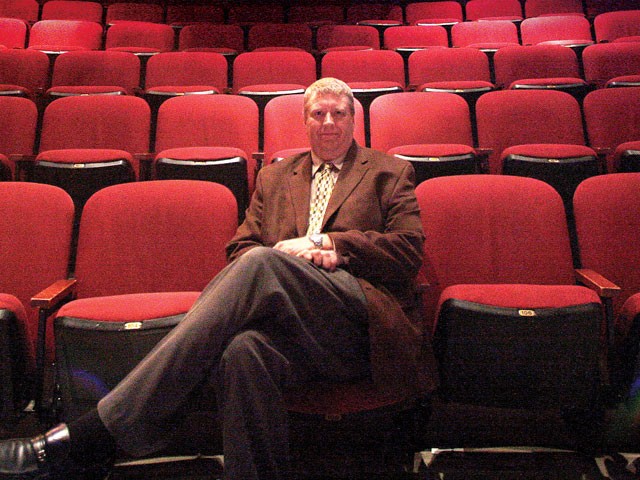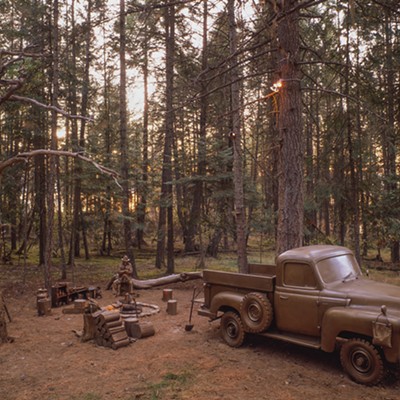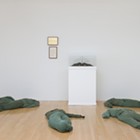THEATER IN SPOKANE GROWS, THEN SHRINKS
Back before Michael Weaver started Actors Rep theater in 2004, the skepticism was that Spokane wouldn’t support a second theater (in addition to Interplayers) at which a) the cast and crew rehearsed full-time during the day and were paid salaries and b) the programming consisted mostly of classic and near-contemporary non-musical plays.
Tim Behrens poured his mother’s money (and his own) for five years into a dinner theater/jazz club/wedding reception/rehearsal hall conglomeration that was a noble effort but profitable only in part.
But once ARt fizzled after 4.2 seasons and Spokane’s best-ambience-ever jazz club went silent, the question became: How can we get them back? Because there was plenty of cultural room for them around here.
Actors Rep and CenterStage both collapsed in fall 2008, leaving the local theater scene dominated by a community theater and a summer-stock company that emphasize main-stage musicals. At both ARt and CenterStage, better financial management would have extended the runs. Better attendance — and increased attentiveness to box-office draws — would have helped too. Yvonne A.K. Johnson has led the Civic onto a solid financial footing, and Roger Welch of Coeur d’Alene Summer Theatre has tackled ambitious musicals; their example has merited local backing. Both lead well-run organizations. Playgoers who prefer conversational comedies and psychological dramas, however, are left shortchanged.
Looking forward, then, there are dual responsibilities: Nonprofit arts organizations need to husband their slim financial resources, and local butts need to fill local seats. Just as buying mom-and-pop coffee slows the Starbucks tsunami, buying local helps with the arts, too. (MB)
GET LIT! GOES BIG
Long a nice, respectable regional festival, Get Lit! took off in 2003. It was five days long, and the names were national, not just regional. Sure, Lynda Barry and Jack Prelutsky both had Northwest ties, but not David Sedaris.
Sedaris represented everything Spokane was not — urbane, snarky, erudite-even-when-being-vulgar. Getting David Sedaris here meant we could maybe be a real city for once. Getting David Sedaris here meant we could stuff the ol’ Spokane Inferiority Complex.
While 2003 was an incredible year, 2004 was even more so. That was the year Get Lit! had Kurt Vonnegut, Dave Barry, Garrison Keillor and Sarah Vowell. And Harvey Pekar and Pete Fromm. And Jess Walter. It was the year Get Lit! was held at venues ranging from the Davenport to Catacombs to the EWU campus to the Met (now the Bing Crosby Theater). Writers visited schools, spreading the Get Lit! gospel, and attendance for that year’s festival was an unprecedented 10,000. Yet another banner year was 2005, with visits from Salman Rushdie and poet Rita Dove, as well as a return visit by Sedaris.
How did this happen? Two words: Scott Poole. I know that a lot of people worked very hard to make Get Lit! the success it became — but looking back, it was Poole who had the audacity to imagine it in the first place. He had both crazy energy and a sort of wide-eyed innocence that made people want to help him. He also had an ability to collaborate that continues to shape Get Lit! today.
While Poole eventually moved on to Portland, Get Lit! is now a true community effort encompassing not only EWU but Gonzaga, Whitworth, SFCC, SCC and, this year, even the University of Idaho and the University of Montana. It’s become a yearlong celebration of literature, and although the festival has been hit hard (like everything else) by the stumbling economy, it’s been able to stay in the black while still walking the balance between attracting top-rated talent and honoring local writers.
The way forward? “We are continually trying to think outside of the book box to explore reading, writing and storytelling in new ways,’ says Dani Ringwald, Get Lit’s programs coordinator. “We want to see Get Lit! become the much anticipated April event for our community like our sports equivalents, Bloomsday and Hoopfest, have” in their respective months. (SB)
THE MAC IS BORN, THEN VERY NEARLY DIES
If you can remember the Cheney Cowles Museum, then you remember that it was very Spokane. The Cheney Cowles was small, and nothing about its mid-century edifice inspired the kind of excitement or charitable giving it would need to enter the 21st century.
Wisely, the museum decided to become something else entirely. The Northwest Museum of Arts and Culture (MAC) opened in December 2001 after a $28 million renovation that included new grounds, a new building, new gallery spaces and a new vision.
The museum was still Spokane, but in a new way.
The region´s rich history was celebrated with two showy and interactive opening exhibits, one depicting what life was like for the region´s first peoples, the other showcasing contributions from 50 Inland Northwest «hometowns.» Over the past decade, the MAC has simultaneously brought in big national shows, such as “A T. rex Named Sue” and “Young America,” and its Native American collection has become a Smithsonian affiliate.
Despite the MAC´s crowd-pleasing strategy of bringing in the national while still focusing on the regional, it hasn´t been an easy decade, as 2009 state budget cuts have the museum entering the next decade with 15 fewer employees and a deficit budget of $83,000. It´s quite possible the museum could be closed to the public entirely.
If that were to happen, it'd make the MAC one of the brightest, saddest footnotes of the decade. (SB)
WEST MAIN IS RESURRECTED
In the late 1990s, West Main just off Division was filthy and disconcerting. If you were walking downtown, there was no discernible reason to continue east on Main once you’d reached Auntie’s Bookstore.
The turn of the decade, though, brought change. On the north side of West Main, local artist Dan Spalding began working his cluster of buildings into mixed-use spaces culminating in FSG Yoga (now Lila) and the Rocket Bakery, a dark, gray-green grotto of caffeine consumption that boasted cement tables and period advertising murals. Across the street, Jim Sheehan´s Community Building opened, and with it a flourishing of community activism, services and creativity.
As the decade closes, the LEED platinum-certifi ed Saranac Hotel houses the long-awaited newest incarnation of the Magic Lantern, while foodies and sustainability folks alike are eagerly anticipating the opening of the Main Market Co-op. Situated as it is between the Davenport District, the U-District and the International District, don´t be surprised if the next decade fi nds the blocks surrounding West Main becoming a nexus of culture in Spokane. (SB)
ART MUSIC GETS LESS CLASSICAL (SLIGHTLY)
Don’t they just play elevator music for blue-haired ladies? Be dismissive all you want, but the fact remains that the Spokane Symphony Orchestra, by every measure, is the best and biggest arts organization in town. (Has been for half a century.) Sure, they were reduced to passing the hat — they but responded with responsible belt-tightening. And they’ve got the rock star music director. Their most laudable tendency has been their glacial evolution toward a more casual, more contemporary art music scene: Casual Classics, Symphony on the Edge, remarks from the podium, educational Web features, increased programming of works (Piazzolla, Takemitsu) from the last 30 years instead of just the previous 300. (MB)
UNDERGROUND ART COMES OF AGE
There’s always been an underground in Spokane — especially in Spokane art. That’s a given. But in the 2000s, Spokane not only saw the rise of young, underground artists, but a ready acceptance of them by a slice of the community. Artists like Tiffany Patterson — who was given a neighborhood mural space for her WASPy wallflower ladies in Peaceful Valley. Belt of Vapor drummer Justin Walter gained a venue for his work on the covers


















